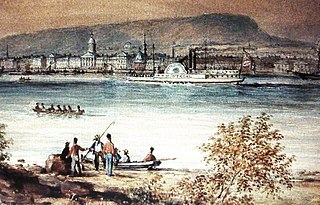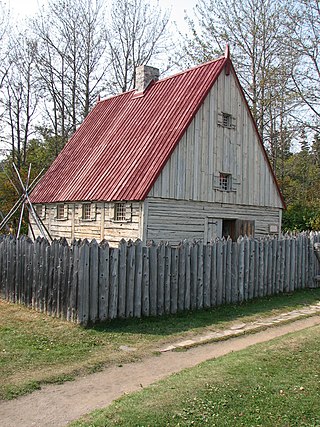Births
| | This section is empty. You can help by adding to it. (June 2010) |
| Years in Quebec: | 1608 1609 1610 1611 1612 1613 1614 |
| Centuries: | 16th century · 17th century · 18th century |
| Decades: | 1580s 1590s 1600s 1610s 1620s 1630s 1640s |
| Years: | 1608 1609 1610 1611 1612 1613 1614 |
Events from the year 1611 in Quebec .
| | This section is empty. You can help by adding to it. (June 2010) |
| | This section is empty. You can help by adding to it. (June 2010) |

Samuel de Champlain was a French explorer, navigator, cartographer, draftsman, soldier, geographer, ethnologist, diplomat, and chronicler. He made between 21 and 29 trips across the Atlantic Ocean, and founded Quebec City, and New France, on 3 July 1608. An important figure in Canadian history, Champlain created the first accurate coastal map during his explorations and founded various colonial settlements.

France began colonizing the Americas in the 16th century and continued into the following centuries as it established a colonial empire in the Western Hemisphere. France established colonies in much of eastern North America, on several Caribbean islands, and in South America. Most colonies were developed to export products such as fish, rice, sugar, and furs.

Jacques Cartier was a French-Breton maritime explorer for France. Jacques Cartier was the first European to describe and map the Gulf of Saint Lawrence and the shores of the Saint Lawrence River, which he named "The Country of Canadas" after the Iroquoian names for the two big settlements he saw at Stadacona and at Hochelaga.

New France was the territory colonized by France in North America, beginning with the exploration of the Gulf of Saint Lawrence by Jacques Cartier in 1534 and ending with the cession of New France to Great Britain and Spain in 1763 under the Treaty of Paris.

A coureur des bois or coureur de bois were independent entrepreneurial French Canadian traders who travelled in New France and the interior of North America, usually to trade with First Nations peoples by exchanging various European items for furs. Some learned the trades and practices of the indigenous peoples.

The Algonquin people are an Indigenous people who now live in Eastern Canada. They speak the Algonquin language, which is part of the Algonquian language family. Culturally and linguistically, they are closely related to the Odawa, Potawatomi, Ojibwe, Mississaugas, and Nipissing, with whom they form the larger Anicinàpe (Anishinaabeg). Algonquins call themselves Omàmiwinini or the more generalised name of Anicinàpe.

This section of the Timeline of Quebec history concerns the events between the foundation of Quebec and establishment of the Sovereign Council.

The 16th century in Canada saw the first contacts, since the Norsemen 500 years earlier, between the indigenous peoples in Canada living near the Atlantic coast and European fishermen, whalers, traders, and explorers.

Events from the 1600s in Canada.

Events from the 1610s in Canada.

Montreal was established in 1642 in what is now the province of Quebec, Canada. At the time of European contact the area was inhabited by the St. Lawrence Iroquoians, a discrete and distinct group of Iroquoian-speaking indigenous people. They spoke Laurentian. Jacques Cartier became the first European to reach the area now known as Montreal in 1535 when he entered the village of Hochelaga on the Island of Montreal while in search of a passage to Asia during the Age of Exploration. Seventy years later, Samuel de Champlain unsuccessfully tried to create a fur trading post but the Mohawk of the Iroquois defended what they had been using as their hunting grounds.

Jean Nicolet (Nicollet), Sieur de Belleborne was a French coureur des bois noted for exploring Lake Michigan, Mackinac Island, Green Bay, and being the first European to set foot in what is now the U.S. state of Wisconsin.

The Company of One Hundred Associates, or Company of New France, was a French trading and colonization company chartered in 1627 to capitalize on the North American fur trade and to expand French colonies there. The company was granted a monopoly to manage the fur trade in the colonies of New France, which were at that time centered on the Saint Lawrence River valley and the Gulf of Saint Lawrence. In return, the company was supposed to settle French Catholics in New France. The Company of One Hundred Associates was dissolved by King Louis XIV, who incorporated New France into a province in 1663.

Louis Hébert is widely considered the first European apothecary in the region that would later become Canada, as well as the first European to farm in said region. He was born around 1575 at 129 de la rue Saint-Honoré in Paris to Nicolas Hébert and Jacqueline Pajot. He loved another woman but according to his father's wish he married Marie Rollet on 19 February 1601 at the Church of Saint-Sulpice, Paris.

The Carignan-Salières Regiment was a 17th-century French military unit formed by the merging of two other regiments in 1659. Approximately 1,100 men from the regiment were sent to New France in 1665 to deal with the threat of the Iroquois to the colony. While in New France they were under the command of the Lieutenant Général of the Americas, Alexandre de Prouville de Tracy; the Governor General, Daniel de Rémy de Courcelle; and their colonel, Henri de Chastelard de Salières. The regiment constructed fortifications along the Richelieu River, and took part in three expeditions against the Iroquois in 1666. A peace settlement was reached the following year. Roughly 400 officers and soldiers remained behind in New France as settlers when the regiment returned to France in 1668.
Events from the year 1610 in Quebec.
François Gravé, said Du Pont, was a Breton navigator, an early fur trader and explorer in the New World.

Pierre de Chauvin de Tonnetuit was a French naval and military captain and a lieutenant of New France who built at Tadoussac, in present-day Quebec, the oldest and strongest surviving French settlement in the Americas.

Fort Ville-Marie was a French fortress and settlement established in May 1642 by a company of French settlers, led by Paul de Chomedey de Maisonneuve, on the Island of Montreal in the Saint Lawrence River at the confluence of the Ottawa River, in what is today the province of Quebec, Canada. Its name is French for "City of Mary", a reference to the Blessed Virgin Mary.
The action of 17 July 1628 took place during the Anglo-French War (1627–1629). The English force led by the Kirke brothers succeeded in capturing a supply convoy bound for New France, severely impairing that colony's ability to resist attack.